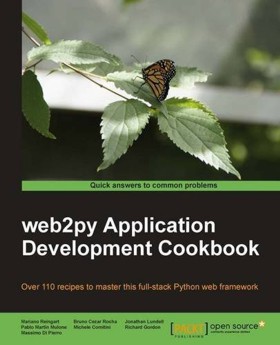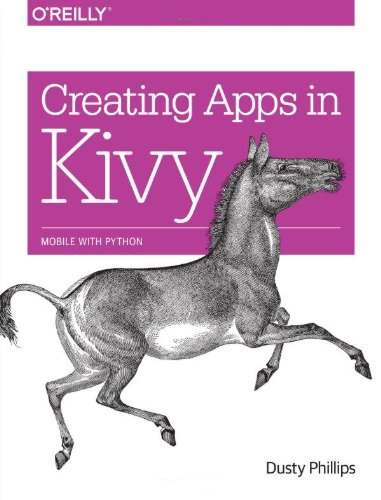| Books for Pythonistas |
| Monday, 03 August 2015 | |||||||
Page 3 of 3
Using Python FrameworksThe books in this section all assume experience with of Python and introduce frameworks that work with the language. All the books in this section have been reviewed by Mike Driscoll, who is also the author of Python 101, included in Python Books For Beginners. Tkinter GUI Application Development HotshotAuthor: Bhaskar Chaudhary Mike Driscoll notes at the start of his review: There aren’t very many Tkinter books in existence, which is something I’ve always found a little odd as it is the GUI toolkit that is included with Python. He also points out that he encountered the book as a technical reviewer for its publisher, Packt Press. The book is split up into Projects instead of chapters and there are seven of them. The first is basically an introduction to Tkinter; the second is creating a simple text editor, like Notepad and the last one covers several mini projects, from creating a screen saver, to building a game, to graphing and several other fun activities. In between you create a programmable drum machine; a Chess game; and audio playing application and a drawing application similar to Paint.
Mike Driscoll says: I personally really enjoyed learning how to make the various applications and games. The variety and creativity are evident and I was surprised how short the programs ended up being. I think I liked the drum machine project the best just because of how unique it was and also because I’ve been a big fan of electronic music for long time. He concludes: If you are looking for some ideas for your first GUI project, regardless of which toolkit you normally use, I would recommend this book. I would also recommend it to anyone wanting to learn Tkinter.
Web2py Application Development CookbookAuthors: Mariano Reingart, Pablo Martin Mulone, Richard Gordon, Bruno Cezar Rocha, Massimo Di Pierro, Michele Comitini and Jonathan Lundell. Web2py is a free, open source web framework written in Python, similar to Django or TurboGears, which includes a web-based IDE to help you manage your web applications.It also includes a database abstraction layer or object relational mapper, similar to SQLAlchemy that will help Python developers connect to many database backends easily.
Mike Driscoll had criticisms of the book that reduced its rating to a 4 mentioning: lots of silly issues that a normal spell check program should have flagged. The writing isn't compelling either, but most cookbooks I've read are that way. He also points out that: most of the examples are incomplete, probably because there just isn't space. but that isn't too much of a problem you can download the full source code from Packt's website.
The book does a have an important redeeming feature - its recipes: What I liked most is that this book actually has recipes that I not only thought were interesting but that I could see myself actually using. There are recipes for integrating PayPal payments, creating CAPTCHAs, building Facebook and Reddit clones, various web service consumer recipes, and some debugging stuff at the end. He concludes his review: I think there are lots of nifty tricks to be learned from this book and I hope to try them out at some point. Creating Apps in KivyAuthor: Dusty Phillips, 2014 Kivy is a package that allows Python developers to create user interfaces on mobile devices. You can also deploy the applications to desktops too. It uses the KV language, which can be thought of as CSS for GUIs.
After of a chapter-by-chapter review, Mike Driscoll states: While I would have liked to have seen other application examples in the book, this text covers all the highlights one would need to know to get started using Kivy. I think if you combine this book with the Kivy documentation and example snippets, you will be well on your way to mastering Kivy.
Author: Ron DuPlain This short book is about Flask, one of Python’s micro-web frameworks. It sets out to create a fully functional scheduling application in Flask and talks about handling requests / responses, static files, forms, using a database (via Flask-SQLAlchemy), templating with Jinja, error responses, authenticating users, sessions and deployment. It is also a cookbook of sorts, as each section is a recipe that is labeled either Simple, Intermediate or Advanced. It introduces lots of interesting plugins, such as Flask-WTForms, and how they work.
Mike Driscoll comments: You’ll find yourself wanting to click on all the various resource links that the author provides so that you can learn all kinds of other things outside of the book. I think this is what the book does best: whetting your appetite such that you want to learn more and more. He concludes: If you’re interested in learning about one of Python’s micro-web frameworks, I think this book will help you get started. |
Expert Performance Indexing in Azure SQL and SQL Server 2022 Author: Edward Pollack & Jason Strate This book discusses indexes, a primary means of improving performance in SQL Server, how does [ ... ] |
Modern Frontend Development with Node.js Author: Florian Rappl |
More Reviews
|
Follow @bookwatchiprog on Twitter or subscribe to I Programmer's Books RSS feed for our new reviews and for each day's new addition to Book Watch and visit Book Watch Archive for hundreds more titles.
You can also follow us on Google+, Linkedin or Facebook or sign up for our weekly newsletter.






